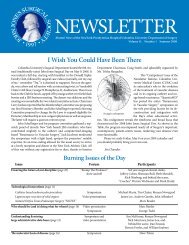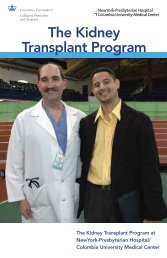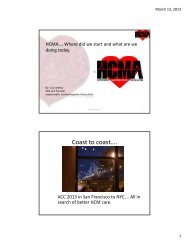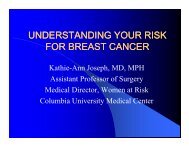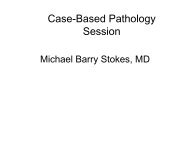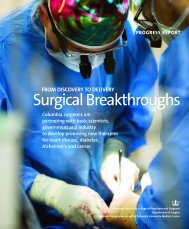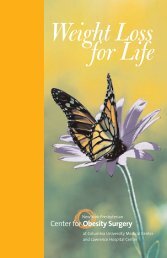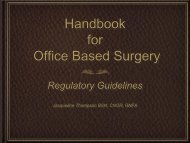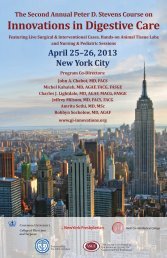NEWSLETTER - Columbia University Department of Surgery
NEWSLETTER - Columbia University Department of Surgery
NEWSLETTER - Columbia University Department of Surgery
Create successful ePaper yourself
Turn your PDF publications into a flip-book with our unique Google optimized e-Paper software.
L. Emmet Holt at age 58 in 1913<br />
efeller Institute’s Scientific Board, as<br />
well as funding for a Babies Hospital<br />
bacteriology laboratory.<br />
Holt’s 1894 text book, The Care<br />
and Feeding <strong>of</strong> Children, had been<br />
translated into Chinese, which ensured<br />
a warm reception. Holt saw<br />
private patients gratis two mornings<br />
a week, lectured twice a week, and<br />
ran a pediatric clinic on Saturdays.<br />
He observed that intestinal parasites<br />
and tuberculosis were common but<br />
rickets was rare as were dental caries.<br />
Children’s diets seldom included<br />
sugar, dairy products or meat, and consisted mainly <strong>of</strong> starches and<br />
vegetables, principally cabbage. The last accounted for the rarity <strong>of</strong><br />
beriberi from lack <strong>of</strong> B1 or scurvy from lack <strong>of</strong> ascorbic acid. Holt<br />
also had a busy social schedule and greatly enjoyed his visit, which<br />
ended tragically with a fatal myocardial infarction on January 14,<br />
1924. His presence for nearly four months stimulated the hiring <strong>of</strong><br />
two staff pediatricians before the beginning <strong>of</strong> summer.<br />
Hans Zinsser (1878-1940)<br />
was PUMC’s Visiting Pr<strong>of</strong>essor<br />
in March 1938. The Japanese had<br />
occupied Peking since the preceding<br />
August and most foreign educational<br />
institutions had moved<br />
south and inland. The Japanese<br />
were hostile to Americans but<br />
must have recognized the value <strong>of</strong><br />
PUMC as a hospital, which made<br />
for an uncomfortable stand<strong>of</strong>f relationship<br />
until 1941 when the Japanese<br />
Army took over the institution.<br />
Samuel Zia, who had been a<br />
Hans Zinsser 24<br />
student <strong>of</strong> Zinsser’s, had worked in<br />
PUMC’s department <strong>of</strong> bacteriol-<br />
ogy since 1921 and was the main attraction for Zinsser. Zia was an expert<br />
on typhus transmission by the human body louse. Long winters,<br />
heavy clothing, and bedding together to keep warm favored the movement<br />
<strong>of</strong> lice from one person to another. For westerners, the rickshaw<br />
blanket was a special hazard as they pulled it about their bare necks for<br />
warmth. Hans Zinsser was an internationally renowned bacteriologist<br />
and a typhus expert by any measure. 24 He had served on typhus commissions<br />
<strong>of</strong> Serbia and Russia, developed large scale rickettsia culture<br />
methods directed at the possible manufacture <strong>of</strong> a vaccine, and had<br />
contracted the disease himself. Zia had a great time proving to Zinsser<br />
that his culture methods were applicable to Zia’s recently isolated European<br />
rickettsia strains. 25 While sailing home, Zinsser became aware<br />
that he was chronically ill with leukemia and knew that he had seen<br />
Peking for the last time.<br />
Graduates and Chinese Faculty<br />
The number <strong>of</strong> students in a class gradually increased, but only<br />
to 25, since the emphasis was on top quality applicants, not mass<br />
education. This policy had to be frequently defended because <strong>of</strong> the<br />
low ratio <strong>of</strong> physicians to China’s population. By 1937, 95% <strong>of</strong> all <strong>of</strong><br />
its 141 graduates up to the class <strong>of</strong> 1933 were teaching in a medical<br />
school, had grant supported research or full time salaried clinical<br />
appointments. 26 As PUMC’s graduates attained seniority they be-<br />
John Jones Surgical Society Volume 13, Number 2 Winter 2010<br />
came academic department chiefs, hospital directors and heads <strong>of</strong><br />
government preventive medicine programs.<br />
The PUMC faculty included Chinese pr<strong>of</strong>essors right from<br />
its start, but they were recruited from US schools. When it graduated<br />
its first class <strong>of</strong> three medical students in 1924, 23 <strong>of</strong> PUMC’s<br />
30 house staff physicians were Chinese graduates generally from the<br />
US, but PUMC graduates and graduates <strong>of</strong> other Chinese medical<br />
schools became dominant as the decade <strong>of</strong> the 20’s closed. The Great<br />
Depression reduced the Rockefeller Foundation’s income, which favored<br />
Chinese applicants for faculty positions because their support<br />
was less expensive. The Ministry <strong>of</strong> Education also intervened to require<br />
at least nominal Chinese leadership <strong>of</strong> all private educational<br />
institutions in 1927 or 28. The Rockefeller Foundation responded by<br />
incorporating the CMB as a separate entity, providing it with a fixed<br />
yearly budget, on a year-by-year basis, and encouraging it to include<br />
Chinese members.<br />
Legacy<br />
The 1937 Japanese invasion stimulated Frank Meleney and<br />
Donald Van Slyke, who were soon joined by Severinghaus and Webster,<br />
to form an American Bureau for Medical Aid to China (AB-<br />
MAC), which sent massive amounts <strong>of</strong> medical supplies to China for<br />
the next 12 years. Former Pediatrics Vice-Chairman, John T. Truman<br />
and <strong>Columbia</strong> trustee, Clyde Wu visited PUMC in the Peoples<br />
Republic, finding it to be physically and spiritually dilapidated. Truman<br />
was there to consult on the 11-year old granddaughter <strong>of</strong> one <strong>of</strong><br />
Left, 11-year old granddaughter in 1979, sick with acute myelocytic leukemia. 18<br />
months <strong>of</strong> aggressive multi-drug chemotherapy supplied and monitored weekly<br />
by John Truman → permanent remission. Right, with her husband and the first <strong>of</strong><br />
her two children in 2004.<br />
Mao Zedong’s old comrades, and Wu first went there in 1992 to see<br />
where Aura Severinghaus had worked. Wu decided to select junior<br />
faculty from its <strong>Department</strong> <strong>of</strong> Medicine as “Wu fellows” to come to<br />
P&S for a year <strong>of</strong> study and now also supports senior P&S Faculty on<br />
educational missions to China. 27<br />
PUMC has been reincarnated as the Chinese Academy <strong>of</strong><br />
Medical Sciences and its name has been reinstated for some <strong>of</strong> the<br />
original buildings. It now welcomes American pr<strong>of</strong>essors and its<br />
faculty is being increasingly seen and heard at our pr<strong>of</strong>essional societies.<br />
On June 14, 2010, the CMB held its semi-annual board meeting<br />
in Beijing at Peking Union Medical College’s Chapel, and three<br />
months later, CMB President Lincoln C. Chen received the People’s<br />
Republic <strong>of</strong> China’s Friendship Award from Vice Premier Zhang<br />
Dejiang in Beijing’s Great Hall <strong>of</strong> the People. 28<br />
PUMC is <strong>of</strong>ten praised as having been a great training ground for<br />
American medicine’s academic giants. They were so well selected that it<br />
is likely that their main gain accrued from a melding <strong>of</strong> their own talents<br />
and the acculturation that they brought back to the US. Several hundred<br />
13



